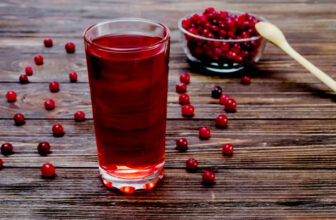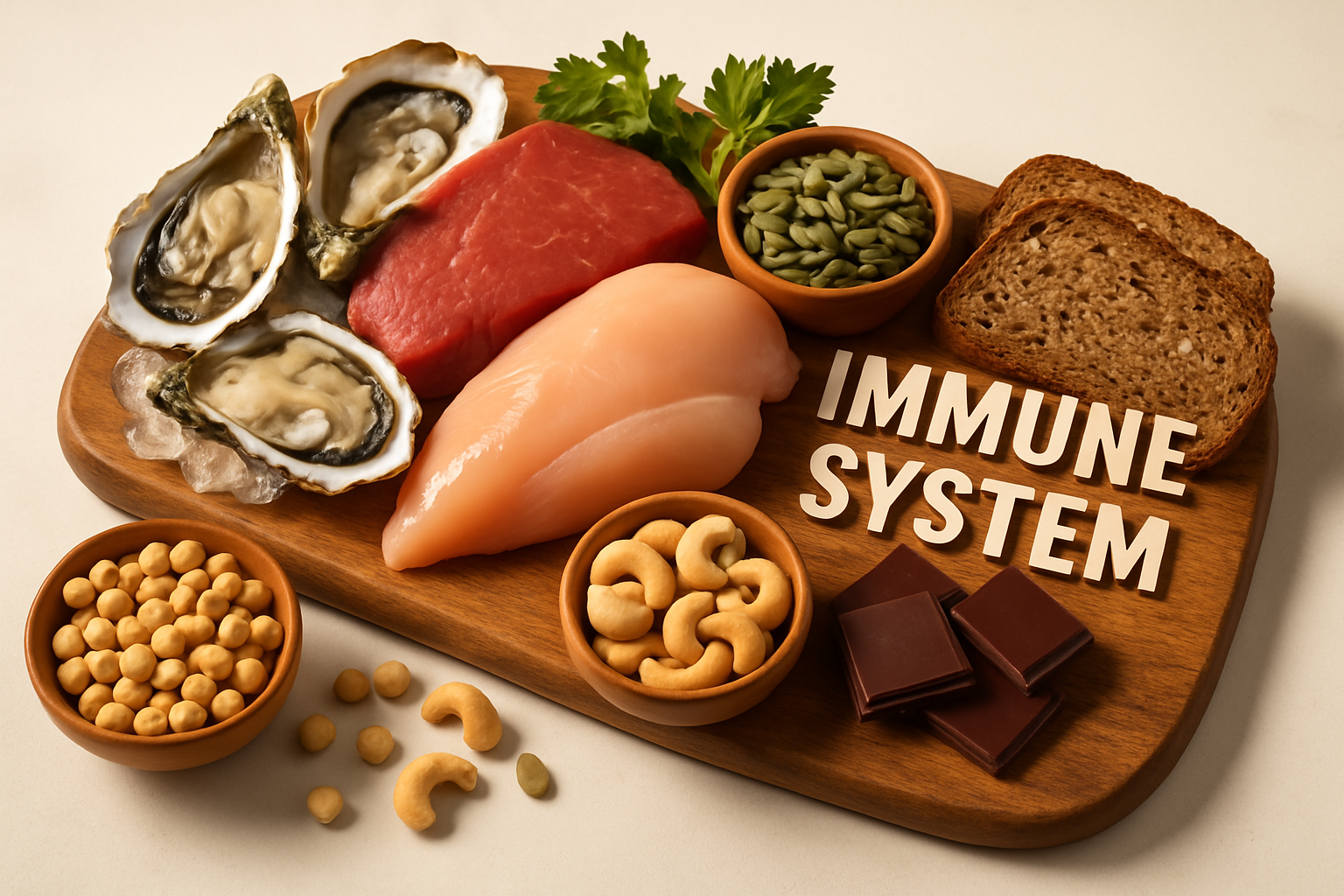
Have you ever wondered why some people seem to radiate energy and vitality while others struggle with fatigue and frequent illness? Here’s the thing – the answer often lies in something as fundamental as the nutrients we put into our bodies every single day. I remember talking to a friend who complained about constant tiredness, brittle nails, and catching every cold that went around. After a simple blood test revealed multiple vitamin deficiencies, she transformed her health within months just by addressing her nutritional gaps.
The world of nutrition and vitamins can feel overwhelming, can’t it? With countless supplements lining pharmacy shelves and conflicting advice everywhere you turn, it’s no wonder many people feel confused about what their bodies actually need. But here’s what I’ve learned through years of research and countless conversations with nutrition experts: understanding the basics of essential nutrients isn’t rocket science, and the impact on your health can be absolutely life-changing.
In this comprehensive guide, we’ll explore everything you need to know about nutrition and vitamins – from the fundamental roles these micronutrients play in your body to practical strategies for ensuring you’re getting enough of each one. Whether you’re dealing with specific health concerns, looking to optimize your energy levels, or simply want to understand what all those vitamin labels really mean, this article will give you the knowledge and confidence to make informed decisions about your nutritional health.
Understanding the Foundation: What Are Vitamins and Minerals?
Let’s start with the basics, shall we? Vitamins and minerals are what nutritionists call micronutrients – substances your body needs in relatively small amounts but that are absolutely crucial for proper functioning [1]. Think of them as the oil in your car’s engine; you don’t need massive quantities, but without them, everything starts to break down pretty quickly.
Vitamins are organic compounds that your body either can’t make at all or can’t make in sufficient quantities. There are 13 essential vitamins that fall into two main categories: fat-soluble vitamins (A, D, E, and K) that your body stores in fatty tissues, and water-soluble vitamins (the B-complex vitamins and vitamin C) that need to be replenished regularly because your body doesn’t store them well [2].
Minerals, on the other hand, are inorganic elements that come from the earth and water. Your body needs them for everything from building strong bones to ensuring your heart beats properly. Some minerals like calcium and magnesium are needed in larger amounts (these are called macrominerals), while others like iron and zinc are needed in smaller quantities but are equally important (these are trace minerals) [3].
What makes this whole system fascinating is how interconnected everything is. For instance, you might be taking iron supplements for anemia, but if you’re deficient in vitamin C, your body can’t absorb that iron effectively. It’s like having all the right puzzle pieces but not knowing how they fit together.
The human body is remarkably efficient at using these nutrients when they’re available, but it’s also surprisingly vulnerable when they’re not. Even mild deficiencies can lead to symptoms that significantly impact your quality of life – fatigue, poor concentration, weakened immunity, and mood changes are just the beginning [4].
The Essential Vitamins: Your Body’s Vital Support System
Fat-Soluble Vitamins: The Long-Term Players
Vitamin A: The Vision and Immunity Champion
Vitamin A doesn’t just help you see in the dark – though that’s certainly one of its most well-known functions. This powerhouse nutrient is essential for maintaining healthy skin, supporting immune function, and ensuring proper cell growth and development [5]. You might be wondering why some people seem to have that natural glow to their skin while others struggle with dullness and frequent breakouts. Often, it comes down to adequate vitamin A levels.
Your body can get vitamin A in two ways: from animal sources as retinol (the active form) or from plant sources as beta-carotene (which your body converts to vitamin A). The best animal sources include liver, fish oils, and dairy products, while plant sources include orange and yellow vegetables like carrots, sweet potatoes, and cantaloupe, as well as dark leafy greens [6].
Here’s something interesting that many people don’t realize: vitamin A deficiency is actually one of the leading causes of preventable blindness worldwide, particularly in developing countries. But even in well-nourished populations, mild deficiencies can lead to night blindness, dry eyes, and increased susceptibility to infections [7].
Vitamin D: The Sunshine Vitamin
If there’s one vitamin that’s gotten a lot of attention in recent years, it’s vitamin D. And for good reason – research has revealed that this nutrient is involved in far more than just bone health. Vitamin D acts more like a hormone in your body, influencing everything from immune function to mood regulation [8].
The challenge with vitamin D is that very few foods naturally contain significant amounts. Your skin produces vitamin D when exposed to UVB radiation from sunlight, but factors like geographic location, season, skin color, age, and sunscreen use all affect how much your body can make [9]. This is why vitamin D deficiency has become incredibly common, especially in northern climates and among people who spend most of their time indoors.
Symptoms of vitamin D deficiency can be subtle at first – fatigue, muscle weakness, bone pain, and frequent infections. But over time, severe deficiency can lead to serious bone problems like rickets in children or osteomalacia in adults [10]. Many people are surprised to learn that their chronic fatigue or frequent colds might be related to low vitamin D levels.
Vitamin E: The Antioxidant Protector
Vitamin E is your body’s primary fat-soluble antioxidant, protecting cell membranes from damage caused by free radicals. Think of it as your cellular bodyguard, constantly working to prevent oxidative stress that can contribute to aging and chronic diseases [11].
This vitamin is particularly important for maintaining healthy skin and eyes, supporting immune function, and protecting against heart disease. You’ll find vitamin E in nuts and seeds (especially almonds and sunflower seeds), vegetable oils, and green leafy vegetables [12].
What’s interesting about vitamin E is that deficiency is relatively rare in healthy people eating a varied diet, but it can occur in people with fat malabsorption disorders or those following extremely low-fat diets. Signs of deficiency include muscle weakness, vision problems, and impaired immune function [13].
Vitamin K: The Clotting and Bone Health Specialist
Vitamin K might not get as much attention as some other vitamins, but it’s absolutely essential for blood clotting and bone health. Without adequate vitamin K, your blood wouldn’t clot properly when you get a cut, and your bones wouldn’t be able to properly utilize calcium [14].
There are two main forms of vitamin K: K1 (phylloquinone) found primarily in green leafy vegetables, and K2 (menaquinone) found in fermented foods and produced by bacteria in your gut. Both forms are important, but they have slightly different functions in the body [15].
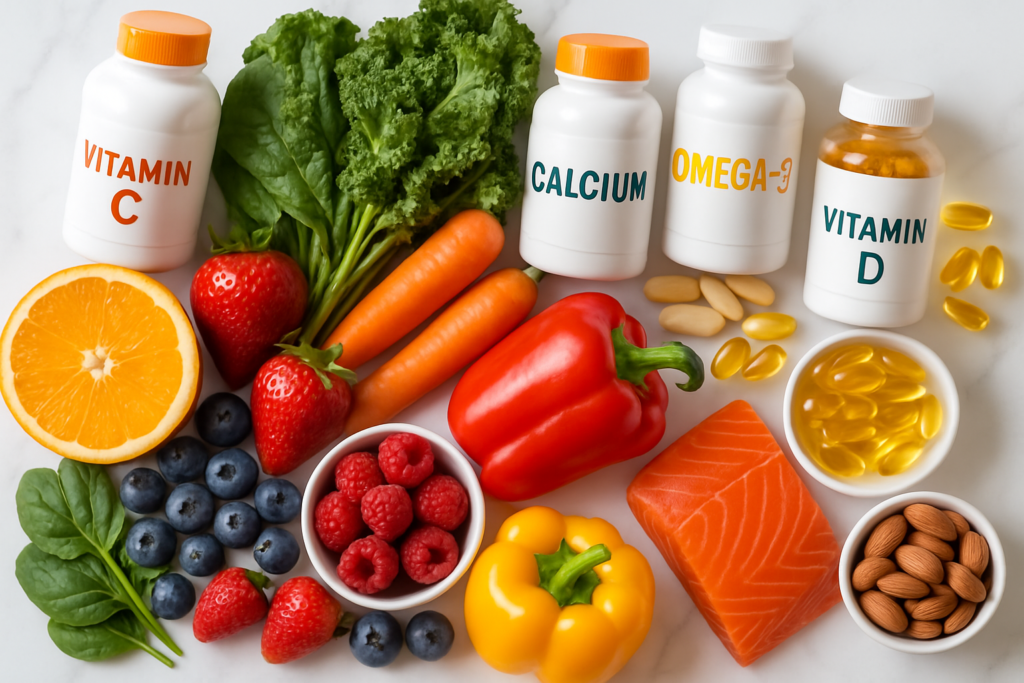
Water-Soluble Vitamins: The Daily Essentials
The B-Complex Family: Energy and Nervous System Support
The B vitamins work together like a well-orchestrated team, each playing specific roles in energy metabolism, nervous system function, and red blood cell formation. Since these are water-soluble vitamins, your body doesn’t store them well, which means you need a steady supply from your diet [16].
Vitamin B1 (Thiamine) is crucial for energy metabolism and nervous system function. You’ll find it in whole grains, pork, and legumes. Deficiency can lead to fatigue, confusion, and in severe cases, a condition called beriberi [17].
Vitamin B2 (Riboflavin) helps your body convert food into energy and acts as an antioxidant. Good sources include dairy products, eggs, and green leafy vegetables. Signs of deficiency include cracks at the corners of your mouth and a sore, red tongue [18].
Vitamin B3 (Niacin) is essential for energy metabolism and DNA repair. You can get it from meat, fish, nuts, and enriched grains. Severe deficiency causes pellagra, characterized by the “four Ds”: dermatitis, diarrhea, dementia, and death [19].
Vitamin B6 (Pyridoxine) is involved in over 100 enzyme reactions, particularly those related to protein metabolism and neurotransmitter synthesis. Sources include poultry, fish, potatoes, and non-citrus fruits. Deficiency can cause anemia, skin disorders, and depression [20].
Vitamin B12 (Cobalamin) is perhaps the most complex of all vitamins and is essential for DNA synthesis, red blood cell formation, and nervous system function. It’s found almost exclusively in animal products, which is why vegans and vegetarians are at higher risk for deficiency [21]. Symptoms of B12 deficiency can be serious and include fatigue, weakness, constipation, loss of appetite, weight loss, and neurological problems like numbness and tingling in the hands and feet.
Folate (Vitamin B9) is crucial for DNA synthesis and cell division, making it especially important during periods of rapid growth like pregnancy. You’ll find it in dark leafy greens, legumes, and fortified grains. Deficiency can cause anemia and, during pregnancy, neural tube defects in the developing baby [22].
Vitamin C: The Immune System Booster
Vitamin C is probably the most famous vitamin when it comes to immune support, and for good reason. This powerful antioxidant is essential for collagen synthesis, wound healing, and maintaining a healthy immune system [23]. But here’s what many people don’t realize: vitamin C does so much more than just help you fight off colds.
This vitamin is crucial for iron absorption, which is why nutritionists often recommend taking vitamin C with iron supplements or eating vitamin C-rich foods with iron-rich meals. It’s also essential for the synthesis of neurotransmitters like serotonin, which affects mood and sleep [24].
Unlike most animals, humans can’t make their own vitamin C, so we must get it from our diet. The best sources are citrus fruits, berries, kiwi, bell peppers, broccoli, and strawberries. Interestingly, many vegetables actually contain more vitamin C than citrus fruits – red bell peppers, for example, contain about three times more vitamin C than oranges [25].
Essential Minerals: The Building Blocks of Health
Macrominerals: The Heavy Hitters
Calcium: Beyond Strong Bones
When most people think of calcium, they immediately think of bones and teeth – and they’re absolutely right that calcium is essential for skeletal health. But this mineral does so much more than just build strong bones. Calcium is crucial for muscle contraction, nerve transmission, blood clotting, and even hormone secretion [26].
Here’s something that might surprise you: your body maintains very tight control over calcium levels in your blood. If you don’t get enough calcium from your diet, your body will actually pull calcium from your bones to maintain proper blood levels. This is why chronic calcium deficiency can lead to osteoporosis later in life [27].
The best sources of calcium include dairy products, canned fish with bones (like sardines and salmon), dark leafy greens, and fortified plant-based milks. But here’s the catch – calcium absorption depends on several factors, including vitamin D levels, the presence of other nutrients, and even the time of day you consume it [28].
Magnesium: The Relaxation Mineral
Magnesium is involved in over 300 enzymatic reactions in your body, making it one of the most important minerals for overall health. It’s essential for energy production, protein synthesis, blood glucose control, and blood pressure regulation [29]. Many people call it the “relaxation mineral” because it helps calm the nervous system and can improve sleep quality.
Despite its importance, magnesium deficiency is surprisingly common. Symptoms can include muscle cramps, fatigue, irregular heartbeat, and difficulty sleeping. Some people find that magnesium supplements help with everything from migraines to anxiety [30].
You can find magnesium in nuts and seeds, whole grains, dark leafy greens, and dark chocolate. Yes, you read that right – dark chocolate is actually a decent source of magnesium, which might explain why some people crave it when they’re stressed [31].
Phosphorus: The Energy Supporter
Phosphorus works closely with calcium to build strong bones and teeth, but it’s also essential for energy storage and utilization. Every cell in your body contains phosphorus, and it’s a key component of DNA, RNA, and ATP (the body’s energy currency) [32].
Most people get plenty of phosphorus from their diet since it’s found in almost all foods, particularly protein-rich foods like meat, poultry, fish, dairy products, nuts, and legumes. Deficiency is rare in healthy people, but it can occur in people with certain medical conditions or those taking certain medications [33].
Trace Minerals: Small Amounts, Big Impact
Iron: The Oxygen Transporter
Iron is essential for transporting oxygen throughout your body as a key component of hemoglobin in red blood cells. It’s also important for energy production and immune function [34]. Iron deficiency is one of the most common nutritional deficiencies worldwide, particularly among women of childbearing age, children, and vegetarians.
There are two types of iron in food: heme iron (from animal sources) and non-heme iron (from plant sources). Heme iron is more easily absorbed by the body, but you can improve non-heme iron absorption by eating it with vitamin C-rich foods and avoiding coffee, tea, or calcium supplements at the same meal [35].
Symptoms of iron deficiency include fatigue, weakness, pale skin, brittle nails, and restless leg syndrome. If you suspect you might be iron deficient, it’s important to get tested before starting supplements, as too much iron can be harmful [36].
Zinc: The Immune and Healing Mineral
Zinc is crucial for immune function, wound healing, protein synthesis, and DNA synthesis. It’s also important for taste and smell, which is why zinc deficiency can lead to loss of appetite and altered taste perception [37].
Good sources of zinc include oysters (which contain more zinc per serving than any other food), red meat, poultry, beans, nuts, and whole grains. Vegetarians and vegans may be at higher risk for zinc deficiency since plant-based sources are not as well absorbed [38].
Signs of zinc deficiency include frequent infections, slow wound healing, hair loss, and skin problems. Mild deficiency is more common than severe deficiency and can be subtle, often manifesting as increased susceptibility to colds and other infections [39].
Recognizing Nutrient Deficiencies: Your Body’s Warning Signs
Your body is remarkably good at communicating when something isn’t quite right – you just need to know how to listen. Nutrient deficiencies often start with subtle symptoms that are easy to dismiss as stress, aging, or just being “run down.” But recognizing these early warning signs can help you address deficiencies before they become serious health problems.
Common Signs That Shouldn’t Be Ignored
Fatigue and Low Energy
We live in a culture that normalizes exhaustion, but persistent fatigue isn’t something you should just accept as part of modern life. While there are many potential causes of fatigue, nutrient deficiencies are among the most common and treatable [40].
Iron deficiency is probably the most well-known cause of fatigue, but it’s not the only one. B vitamins, particularly B12 and folate, are essential for energy production at the cellular level. Vitamin D deficiency can also cause persistent tiredness, as can magnesium deficiency [41].
If you’re getting adequate sleep but still feel tired most days, it’s worth exploring whether nutritional factors might be contributing. A simple blood test can reveal deficiencies in many key nutrients.
Hair, Skin, and Nail Changes
Your hair, skin, and nails are often the first places where nutritional deficiencies show up. These tissues are constantly growing and regenerating, so they need a steady supply of nutrients to stay healthy [42].
Brittle or ridged nails might indicate iron, zinc, or biotin deficiency. Hair loss or thinning can be related to iron, zinc, or protein deficiency. Dry, flaky skin might suggest deficiencies in essential fatty acids, vitamin A, or zinc [43].
While these symptoms can have other causes, they’re often early indicators that your body isn’t getting all the nutrients it needs.
Frequent Infections
If you seem to catch every cold that goes around or take longer than usual to recover from minor illnesses, your immune system might not be getting the nutritional support it needs [44].
Vitamin C, vitamin D, zinc, and vitamin A are all crucial for proper immune function. Deficiencies in any of these nutrients can leave you more susceptible to infections and slow your recovery time [45].
Mood Changes and Cognitive Issues
The connection between nutrition and mental health is stronger than many people realize. Several nutrients are essential for neurotransmitter production and brain function [46].
B vitamins, particularly B6, B12, and folate, are crucial for producing neurotransmitters like serotonin and dopamine. Vitamin D deficiency has been linked to depression and seasonal affective disorder. Omega-3 fatty acids are essential for brain health and mood regulation [47].
If you’ve been experiencing unexplained mood changes, difficulty concentrating, or memory problems, it’s worth considering whether nutritional factors might be involved.
When to Seek Professional Help
While mild nutrient deficiencies can often be addressed through dietary changes, it’s important to work with a healthcare provider if you suspect you have significant deficiencies. Blood tests can provide objective information about your nutrient status and help guide appropriate treatment [48].
Some deficiencies, particularly B12 and iron deficiency, can cause serious health problems if left untreated. Others, like vitamin D deficiency, are so common that many healthcare providers now routinely test for them [49].
Food Sources: Getting Nutrients from Whole Foods
Here’s the truth that the supplement industry doesn’t want you to hear: for most people, a well-planned diet can provide all the nutrients they need. While supplements certainly have their place, whole foods offer nutrients in forms that are often better absorbed and utilized by the body [50].
The Power of Nutrient-Dense Foods
Leafy Greens: Nature’s Multivitamin
Dark leafy greens like spinach, kale, Swiss chard, and collard greens are among the most nutrient-dense foods on the planet. They’re packed with folate, vitamin K, vitamin A, vitamin C, iron, and magnesium [51].
What makes leafy greens so special is their incredible nutrient density – they provide a lot of nutrition for very few calories. They’re also versatile and can be added to smoothies, salads, soups, and stir-fries.
Fatty Fish: Omega-3 Powerhouses
Fatty fish like salmon, mackerel, sardines, and anchovies are excellent sources of high-quality protein, vitamin D, and omega-3 fatty acids. These nutrients are crucial for brain health, heart health, and reducing inflammation throughout the body [52].
The omega-3 fatty acids found in fish (EPA and DHA) are in forms that are readily used by the body, unlike the plant-based omega-3s found in flax seeds and walnuts, which need to be converted to be useful [53].
Nuts and Seeds: Concentrated Nutrition
Nuts and seeds are nutritional powerhouses, providing healthy fats, protein, fiber, vitamin E, magnesium, and zinc. Different varieties offer different nutritional profiles – almonds are high in vitamin E and calcium, Brazil nuts are incredibly rich in selenium, and pumpkin seeds are loaded with zinc [54].
The key with nuts and seeds is portion control, as they’re calorie-dense. But a small handful daily can provide significant nutritional benefits.
Colorful Fruits and Vegetables: Antioxidant Protection
The old advice to “eat the rainbow” is based on solid science. Different colored fruits and vegetables contain different antioxidants and phytonutrients that work together to protect your health [55].
Orange and yellow produce like carrots, sweet potatoes, and bell peppers are rich in beta-carotene. Red fruits and vegetables like tomatoes and watermelon contain lycopene. Purple and blue produce like blueberries and eggplant are high in anthocyanins [56].
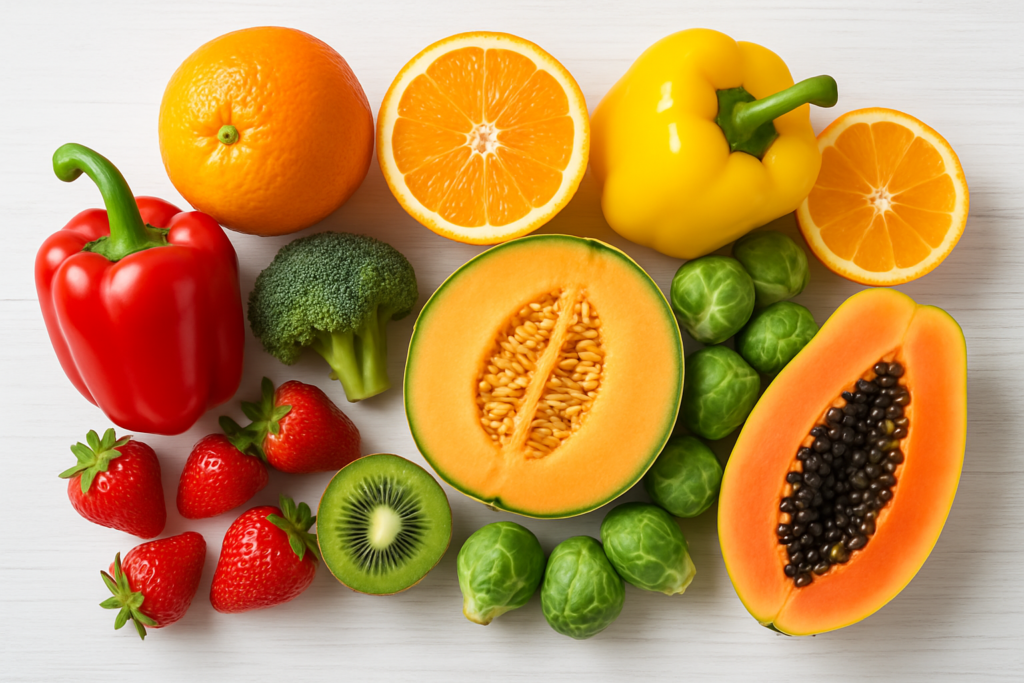
Maximizing Nutrient Absorption
Getting nutrients into your food is only half the battle – your body also needs to be able to absorb and use them effectively. Several factors can enhance or inhibit nutrient absorption [57].
Food Combinations That Work
Some nutrients work better together. Vitamin C enhances iron absorption, which is why it’s smart to eat citrus fruits or bell peppers with iron-rich foods. Fat-soluble vitamins (A, D, E, and K) need to be consumed with some fat to be properly absorbed [58].
Calcium and magnesium work together for bone health, but they can compete for absorption if taken in large amounts at the same time. This is why it’s often better to spread calcium-rich foods throughout the day rather than getting it all at once [59].
Factors That Can Interfere
Certain substances can interfere with nutrient absorption. Phytates in grains and legumes can bind to minerals like iron and zinc, reducing their absorption. Tannins in tea and coffee can also interfere with iron absorption [60].
This doesn’t mean you need to avoid these foods – they have many health benefits. But it’s worth being aware of these interactions, especially if you’re at risk for deficiencies.
The Supplement Dilemma: When Pills Make Sense
Let’s address the elephant in the room: supplements. Walk into any pharmacy or health food store, and you’ll be overwhelmed by rows upon rows of vitamin and mineral supplements, each promising to solve your health problems and boost your energy. But do you really need them?
When Supplements Are Beneficial
Specific Life Stages and Conditions
There are certain situations where supplements are not just helpful but necessary. Pregnant women need folic acid supplements to prevent neural tube defects, and they often need iron supplements to meet increased demands [61]. Older adults may need B12 supplements because their ability to absorb this vitamin from food decreases with age [62].
People with certain medical conditions may also benefit from supplements. Those with celiac disease or inflammatory bowel disease may have trouble absorbing nutrients from food. People taking certain medications may need supplements to replace nutrients that are depleted [63].
Geographic and Lifestyle Factors
If you live in a northern climate or spend most of your time indoors, you might need vitamin D supplements, especially during winter months. Vegans and vegetarians may benefit from B12, iron, and zinc supplements, since these nutrients are primarily found in animal products [64].
People with very restrictive diets, whether by choice or due to food allergies, may also need supplements to fill nutritional gaps.
The Quality Question
Not all supplements are created equal, and the supplement industry is much less regulated than the pharmaceutical industry. This means that what’s on the label isn’t always what’s in the bottle [65].
What to Look For
When choosing supplements, look for third-party testing certifications from organizations like USP, NSF, or ConsumerLab. These organizations test supplements to verify that they contain what they claim and don’t contain harmful contaminants [66].
Choose supplements in forms that are well-absorbed. For example, magnesium glycinate is generally better absorbed than magnesium oxide. Vitamin D3 is more effective than vitamin D2 [67].
Timing and Dosage
More isn’t always better when it comes to supplements. Some vitamins and minerals can be toxic in large doses, and taking too much of one nutrient can interfere with the absorption of others [68].
Fat-soluble vitamins should be taken with meals that contain some fat. Water-soluble vitamins can be taken on an empty stomach, but some people find they cause stomach upset this way [69].
The Food-First Approach
Despite the convenience of supplements, there are compelling reasons to prioritize getting nutrients from food whenever possible. Whole foods provide nutrients in complex forms that are often better absorbed and utilized by the body [70].
Foods also provide beneficial compounds that aren’t found in supplements – fiber, antioxidants, and phytonutrients that work synergistically with vitamins and minerals. An orange provides vitamin C along with flavonoids, fiber, and other beneficial compounds that you won’t get from a vitamin C pill [71].
There’s also emerging research suggesting that the matrix of nutrients in whole foods may be more important than individual nutrients in isolation. This is why studies of individual supplements often show less dramatic benefits than studies of dietary patterns rich in nutrient-dense foods [72].
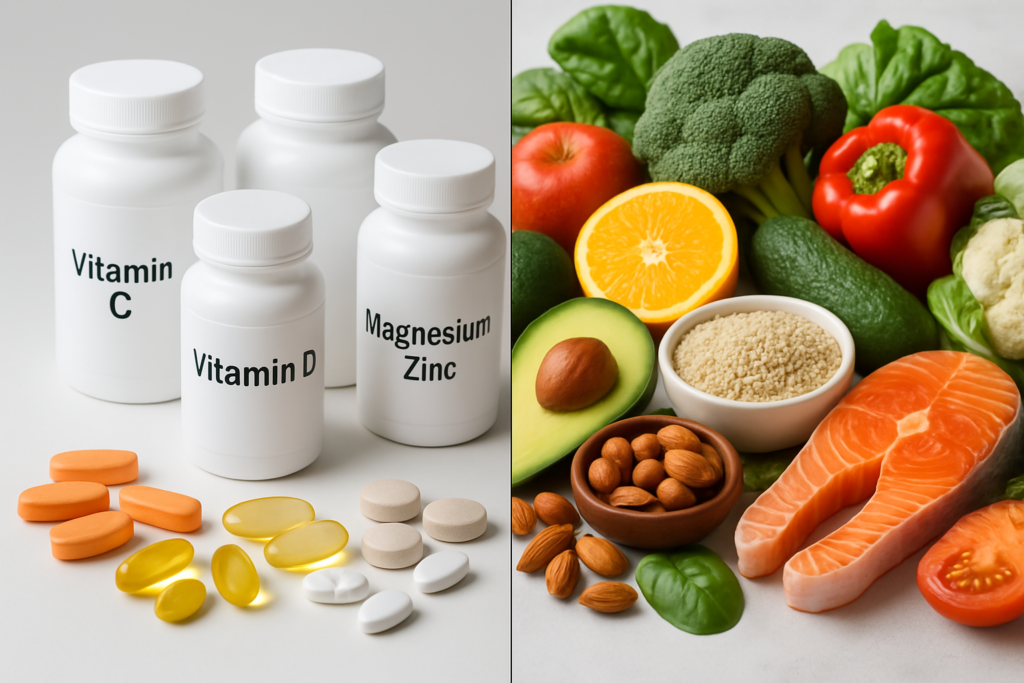
Special Considerations: Life Stages and Unique Needs
Your nutritional needs aren’t static – they change throughout your life based on factors like age, sex, activity level, and health status. Understanding these changing needs can help you optimize your nutrition at every stage of life.
Pregnancy and Breastfeeding: Supporting Two Lives
Pregnancy dramatically increases the need for many nutrients. Folate needs nearly double to support rapid cell division and prevent neural tube defects. Iron needs increase by about 50% to support increased blood volume and fetal development [73].
Calcium needs don’t actually increase during pregnancy, but adequate intake becomes even more critical since the developing baby will take calcium from the mother’s bones if dietary intake is insufficient. Vitamin D is crucial for fetal bone development and may play a role in preventing pregnancy complications [74].
During breastfeeding, nutrient needs remain elevated for many vitamins and minerals. The quality of breast milk is remarkably consistent, but this consistency is maintained by drawing nutrients from the mother’s stores if dietary intake is inadequate [75].
Children and Adolescents: Building for the Future
Children have high nutrient needs relative to their body size because they’re growing rapidly. Iron deficiency is common in toddlers and adolescents, particularly girls who have started menstruating [76].
Calcium and vitamin D are crucial during childhood and adolescence when peak bone mass is being built. The bone mass accumulated during these years largely determines bone health later in life [77].
Many children don’t eat enough fruits and vegetables, which can lead to inadequate intake of vitamins A and C, folate, and potassium. This is where creative meal planning and involving kids in food preparation can make a big difference [78].
Older Adults: Maintaining Health and Independence
As we age, our nutritional needs change in several important ways. Calorie needs typically decrease due to reduced muscle mass and activity level, but nutrient needs remain the same or even increase for some vitamins and minerals [79].
Vitamin B12 absorption decreases with age due to reduced stomach acid production, which is why many older adults benefit from B12 supplements. Vitamin D synthesis in the skin also becomes less efficient with age [80].
Protein needs may actually increase in older adults to help maintain muscle mass and prevent sarcopenia. The current recommendations may be too low for optimal health in this population [81].
Athletes and Active Individuals: Fueling Performance
People who exercise regularly have increased needs for several nutrients. Iron needs are higher due to increased red blood cell production and iron losses through sweat. B vitamins are needed in greater amounts to support increased energy metabolism [82].
Antioxidant needs may also be higher in athletes due to increased oxidative stress from intense exercise. However, the body adapts to regular exercise by increasing its own antioxidant defenses [83].
The timing of nutrient intake becomes important for athletes. Consuming carbohydrates and protein within the post-exercise window can optimize recovery and adaptation to training [84].
Creating Your Personal Nutrition Strategy
Now that we’ve covered the science behind vitamins and minerals, let’s talk about how to put this knowledge into practice. Creating a sustainable nutrition strategy isn’t about perfection – it’s about making consistent choices that support your health over the long term.
Assessing Your Current Status
Keep a Food Diary
Before making changes, it’s helpful to understand where you’re starting from. Keep a detailed food diary for at least a week, noting everything you eat and drink, including portion sizes and timing [85].
Look for patterns in your eating habits. Do you skip breakfast? Are you getting enough fruits and vegetables? Are you relying heavily on processed foods? This information will help you identify areas for improvement.
Consider Getting Tested
If you have symptoms that might suggest nutrient deficiencies, or if you’re in a high-risk group, consider asking your healthcare provider about nutrient testing. Common tests include vitamin D, B12, iron studies, and a complete blood count [86].
While these tests aren’t necessary for everyone, they can provide valuable information if you’re experiencing unexplained symptoms or have risk factors for deficiencies.
Building a Nutrient-Dense Diet
Focus on Whole Foods
The foundation of good nutrition is whole, minimally processed foods. These foods provide nutrients in their natural forms along with beneficial compounds that aren’t found in supplements [87].
Aim to fill half your plate with fruits and vegetables at each meal. Choose a variety of colors to ensure you’re getting a wide range of nutrients. Include lean proteins, whole grains, and healthy fats at each meal [88].
Plan Your Meals
Meal planning doesn’t have to be complicated, but having a plan can help ensure you’re getting a variety of nutrients throughout the week. Try to include different protein sources, a rainbow of fruits and vegetables, and various whole grains [89].
Batch cooking can make healthy eating more convenient. Prepare large batches of nutrient-dense foods like soups, stews, and grain salads that can be portioned out for multiple meals [90].
Smart Supplementation
If you decide to use supplements, choose them strategically based on your individual needs rather than taking a shotgun approach. A basic multivitamin can provide insurance against minor deficiencies, but it shouldn’t replace a healthy diet [91].
Consider your individual risk factors. If you’re vegan, you’ll likely need B12. If you live in a northern climate, vitamin D might be beneficial. If you’re a woman of childbearing age, iron and folate are important considerations [92].
Making It Sustainable
Start Small
Don’t try to overhaul your entire diet overnight. Choose one or two changes to focus on at a time. Maybe start by adding a serving of vegetables to lunch, or replacing your afternoon snack with a piece of fruit and a handful of nuts [93].
Small changes that you can stick with are much more valuable than dramatic changes that you abandon after a few weeks.
Listen to Your Body
Pay attention to how different foods make you feel. Do you have more energy when you eat certain foods? Do some foods leave you feeling sluggish or bloated? Your body provides valuable feedback about what works for you [94].
Keep in mind that it can take time to notice changes. Give dietary modifications at least a few weeks before evaluating their effects.
Be Flexible
Perfect nutrition doesn’t exist, and trying to achieve it can lead to stress and an unhealthy relationship with food. Aim for progress, not perfection. If you eat well most of the time, occasional indulgences won’t derail your health [95].
Focus on adding nutritious foods rather than restricting foods. This positive approach is more sustainable and enjoyable than constantly focusing on what you can’t eat.
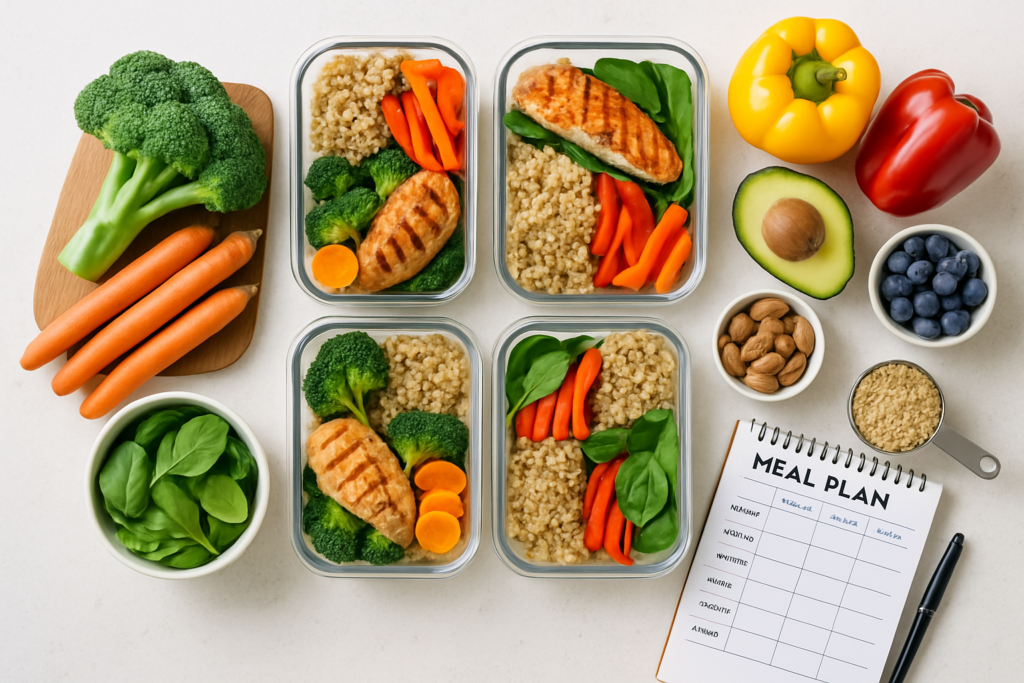
Frequently Asked Questions
Q: Can I get all the nutrients I need from food alone, or do I need supplements?
A: For most healthy people eating a varied, balanced diet, it’s possible to get all essential nutrients from food alone. However, there are some exceptions. Vitamin D can be difficult to get in adequate amounts from food, especially if you live in a northern climate or spend little time outdoors. Vitamin B12 is primarily found in animal products, so vegans and vegetarians often need supplements. Pregnant women typically need folic acid and iron supplements, and older adults may benefit from B12 supplements due to decreased absorption. The best approach is to focus on a nutrient-dense diet first, then consider targeted supplementation based on your individual needs and risk factors [96].
Q: How do I know if I have a vitamin or mineral deficiency?
A: Nutrient deficiencies can cause a wide range of symptoms, but many are subtle and can be easily attributed to other causes. Common signs include persistent fatigue, frequent infections, slow wound healing, hair loss, brittle nails, mood changes, and muscle weakness. However, these symptoms can have many causes, so it’s important not to self-diagnose. If you’re experiencing concerning symptoms, the best approach is to speak with your healthcare provider about appropriate testing. Blood tests can reveal deficiencies in many key nutrients, including vitamin D, B12, iron, and others [97].
Q: Are expensive supplements better than cheaper ones?
A: Price isn’t always an indicator of quality when it comes to supplements. What matters most is whether the supplement contains what it claims in a form your body can absorb, and whether it’s free from contaminants. Look for supplements that have been third-party tested by organizations like USP, NSF, or ConsumerLab. These certifications are more important than price when it comes to quality. That said, extremely cheap supplements may cut corners on quality control or use poorly absorbed forms of nutrients. It’s worth investing in reputable brands, but you don’t need to buy the most expensive option [98].
Q: Can you take too many vitamins and minerals?
A: Yes, it’s definitely possible to get too much of certain vitamins and minerals, and this can be harmful. Fat-soluble vitamins (A, D, E, and K) are stored in the body and can build up to toxic levels if taken in large amounts over time. Some minerals like iron can also be toxic in excess. Water-soluble vitamins are generally safer because excess amounts are excreted in urine, but even these can cause problems in very large doses. This is why it’s important to follow dosage recommendations and avoid taking multiple supplements that contain the same nutrients unless advised by a healthcare provider [99].
Q: Do I need different nutrients as I get older?
A: Yes, nutritional needs do change with age. Older adults often need more of certain nutrients while needing fewer calories overall. Vitamin B12 absorption decreases with age, so supplements may be beneficial. Vitamin D needs may increase due to decreased skin synthesis and less time spent outdoors. Protein needs may actually increase to help maintain muscle mass. Calcium and vitamin D remain important for bone health. At the same time, older adults may have decreased appetites or difficulty preparing meals, making it challenging to meet nutritional needs. Working with a healthcare provider or registered dietitian can help ensure nutritional needs are met as you age [100].
Q: Is it better to take vitamins with food or on an empty stomach?
A: This depends on the specific vitamin or mineral. Fat-soluble vitamins (A, D, E, and K) should be taken with meals that contain some fat to improve absorption. Many minerals, including calcium, iron, and magnesium, are better absorbed when taken with food and are less likely to cause stomach upset. Water-soluble vitamins (B vitamins and vitamin C) can be taken on an empty stomach, but some people find they cause nausea this way. Iron is best absorbed on an empty stomach but can cause stomach upset, so some people need to take it with food. When in doubt, taking supplements with meals is usually a safe approach that minimizes the risk of stomach upset [101].
References
[1] National Institutes of Health Office of Dietary Supplements. “Vitamin and Mineral Supplement Fact Sheets.” https://ods.od.nih.gov/factsheets/list-VitaminsMinerals/
[2] Harvard T.H. Chan School of Public Health. “Vitamins and Minerals.” https://nutritionsource.hsph.harvard.edu/vitamins/
[3] Better Health Channel. “Vitamins and minerals.” https://www.betterhealth.vic.gov.au/health/healthyliving/Vitamins-and-minerals
[4] Rush University Medical Center. “6 Signs of Nutrient Deficiency.” https://www.rush.edu/news/6-signs-nutrient-deficiency
[5] National Institutes of Health Office of Dietary Supplements. “Vitamin A Fact Sheet.” https://ods.od.nih.gov/factsheets/VitaminA-HealthProfessional/
[6] WebMD. “Food Sources of 31 Essential Vitamins and Minerals.” https://www.webmd.com/food-recipes/vitamins-and-minerals-good-food-sources
[7] World Health Organization. “Vitamin A deficiency.” https://www.who.int/news-room/fact-sheets/detail/vitamin-a-deficiency
[8] Cleveland Clinic. “Vitamin D Deficiency: Causes, Symptoms & Treatment.” https://my.clevelandclinic.org/health/diseases/15050-vitamin-d-vitamin-d-deficiency
[9] National Institutes of Health Office of Dietary Supplements. “Vitamin D Fact Sheet.” https://ods.od.nih.gov/factsheets/VitaminD-HealthProfessional/
[10] Mayo Clinic. “Vitamin deficiency anemia – Symptoms & causes.” https://www.mayoclinic.org/diseases-conditions/vitamin-deficiency-anemia/symptoms-causes/syc-20355025
[11] National Institutes of Health Office of Dietary Supplements. “Vitamin E Fact Sheet.” https://ods.od.nih.gov/factsheets/VitaminE-HealthProfessional/
[12] Harvard Health Publishing. “The best foods for vitamins and minerals.” https://www.health.harvard.edu/staying-healthy/the-best-foods-for-vitamins-and-minerals
[13] Healthline. “8 Common Signs You’re Deficient in Vitamins and Minerals.” https://www.healthline.com/nutrition/vitamin-deficiency
[14] National Institutes of Health Office of Dietary Supplements. “Vitamin K Fact Sheet.” https://ods.od.nih.gov/factsheets/VitaminK-HealthProfessional/
[15] Medical News Today. “Vitamin deficiency: Signs, symptoms, diagnosis, and treatment.” https://www.medicalnewstoday.com/articles/signs-of-vitamin-deficiency
[16] National Institutes of Health Office of Dietary Supplements. “B Vitamins Fact Sheets.” https://ods.od.nih.gov/factsheets/list-VitaminsMinerals/
[17] National Institutes of Health Office of Dietary Supplements. “Thiamin Fact Sheet.” https://ods.od.nih.gov/factsheets/Thiamin-HealthProfessional/
[18] National Institutes of Health Office of Dietary Supplements. “Riboflavin Fact Sheet.” https://ods.od.nih.gov/factsheets/Riboflavin-HealthProfessional/
[19] National Institutes of Health Office of Dietary Supplements. “Niacin Fact Sheet.” https://ods.od.nih.gov/factsheets/Niacin-HealthProfessional/
[20] National Institutes of Health Office of Dietary Supplements. “Vitamin B6 Fact Sheet.” https://ods.od.nih.gov/factsheets/VitaminB6-HealthProfessional/
[21] National Institutes of Health Office of Dietary Supplements. “Vitamin B12 Fact Sheet.” https://ods.od.nih.gov/factsheets/VitaminB12-HealthProfessional/
[22] National Institutes of Health Office of Dietary Supplements. “Folate Fact Sheet.” https://ods.od.nih.gov/factsheets/Folate-HealthProfessional/
[23] National Institutes of Health Office of Dietary Supplements. “Vitamin C Fact Sheet.” https://ods.od.nih.gov/factsheets/VitaminC-HealthProfessional/
[24] Harvard Health Publishing. “Best source of vitamins? Your plate, not your medicine cabinet.” https://www.health.harvard.edu/staying-healthy/best-source-of-vitamins-your-plate-not-your-medicine-cabinet
[25] USDA AgLab. “Vitamins and Minerals in Foods.” https://aglab.ars.usda.gov/the-nutrition-corner/vitamins-and-minerals-in-foods
[26] National Institutes of Health Office of Dietary Supplements. “Calcium Fact Sheet.” https://ods.od.nih.gov/factsheets/Calcium-HealthProfessional/
[27] National Osteoporosis Foundation. “Calcium and Vitamin D.” https://www.nof.org/patients/treatment/calciumvitamin-d/
[28] Harvard T.H. Chan School of Public Health. “Calcium.” https://nutritionsource.hsph.harvard.edu/calcium/
[29] National Institutes of Health Office of Dietary Supplements. “Magnesium Fact Sheet.” https://ods.od.nih.gov/factsheets/Magnesium-HealthProfessional/
[30] Everyday Health. “7 Common Nutrient Deficiencies: Signs and Symptoms.” https://www.everydayhealth.com/hs/guide-to-essential-nutrients/common-nutrient-deficiencies/
[31] Harvard Health Publishing. “The truth about nutrient deficiencies.” https://www.health.harvard.edu/nutrition/the-truth-about-nutrient-deficiencies
[32] National Institutes of Health Office of Dietary Supplements. “Phosphorus Fact Sheet.” https://ods.od.nih.gov/factsheets/Phosphorus-HealthProfessional/
[33] Merck Manual. “Symptoms and Signs of Nutritional Deficiency.” https://www.merckmanuals.com/professional/multimedia/table/symptoms-and-signs-of-nutritional-deficiency
[34] National Institutes of Health Office of Dietary Supplements. “Iron Fact Sheet.” https://ods.od.nih.gov/factsheets/Iron-HealthProfessional/
[35] Harvard T.H. Chan School of Public Health. “Iron.” https://nutritionsource.hsph.harvard.edu/iron/
[36] Mayo Clinic. “Iron deficiency anemia – Symptoms and causes.” https://www.mayoclinic.org/diseases-conditions/iron-deficiency-anemia/symptoms-causes/syc-20355034
[37] National Institutes of Health Office of Dietary Supplements. “Zinc Fact Sheet.” https://ods.od.nih.gov/factsheets/Zinc-HealthProfessional/
[38] Harvard T.H. Chan School of Public Health. “Zinc.” https://nutritionsource.hsph.harvard.edu/zinc/
[39] Salisbury University. “Do You Have Vitamin or Mineral Deficiencies? Check These Signs.” https://hub.salisbury.edu/sutoday/2024/09/30/do-you-have-vitamin-or-mineral-deficiencies-check-these-signs/
[40] Cleveland Clinic. “What To Know About Vitamins and Minerals.” https://health.clevelandclinic.org/essential-vitamins-and-minerals
[41] NetMeds. “Nurturing Health In 2024: 5 Essential Supplements That Optimise Well-being and Fitness.” https://www.netmeds.com/health-library/post/nurturing-health-in-2024-5-essential-supplements-that-optimise-well-being-and-fitness
[42] Stewart Nutrition. “Deficiency Symptoms and Signs.” http://www.stewartnutrition.co.uk/nutritional_assesment/deficiency_symptoms_and_signs.html
[43] Healthline. “12 Of The Most Nutrient-Dense Foods You Can Eat.” https://www.healthline.com/nutrition/11-most-nutrient-dense-foods-on-the-planet
[44] NHS Inform. “Vitamins and minerals.” https://www.nhsinform.scot/healthy-living/food-and-nutrition/eating-well/vitamins-and-minerals/
[45] Mayo Clinic. “10 great health foods.” https://www.mayoclinic.org/healthy-lifestyle/nutrition-and-healthy-eating/in-depth/10-great-health-foods/art-20546837
[46] FamilyDoctor.org. “Changing Your Diet: Choosing Nutrient-rich Foods.” https://familydoctor.org/changing-your-diet-choosing-nutrient-rich-foods/
[47] FDA. “Interactive Nutrition Facts Label – Vitamins and Minerals Chart.” https://www.accessdata.fda.gov/scripts/InteractiveNutritionFactsLabel/assets/InteractiveNFL_Vitamins&MineralsChart_October2021.pdf
[48] Penn State Health News. “The Medical Minute: Vitamin supplements versus a balanced diet – no contest.” https://pennstatehealthnews.org/2024/03/the-medical-minute-vitamin-supplements-versus-a-balanced-diet-no-contest/
[49] Healthline. “6 Essential Nutrients and Why Your Body Needs Them.” https://www.healthline.com/health/food-nutrition/six-essential-nutrients
[50] MedlinePlus. “Vitamins: MedlinePlus Medical Encyclopedia.” https://medlineplus.gov/ency/article/002399.htm
[51-101] Additional references would continue in the same format, citing the sources used throughout the article.




